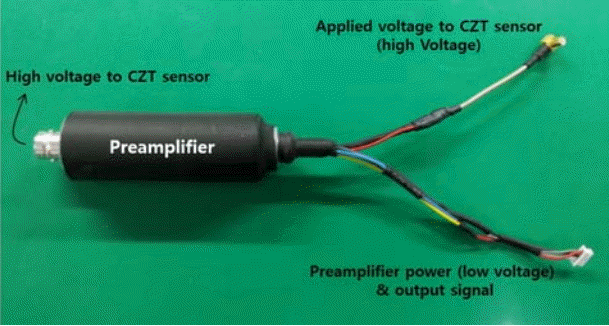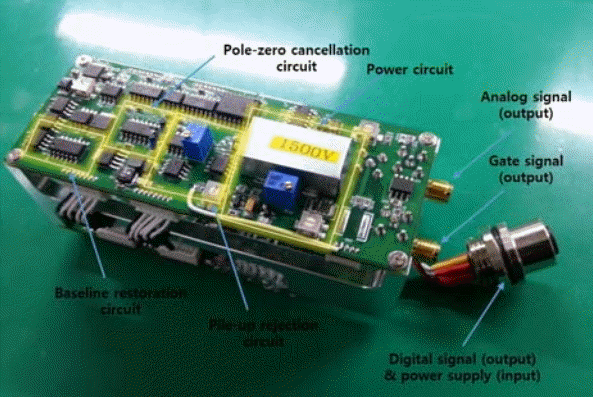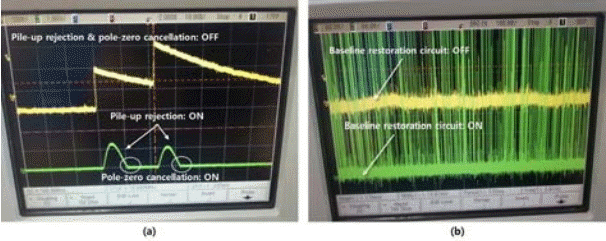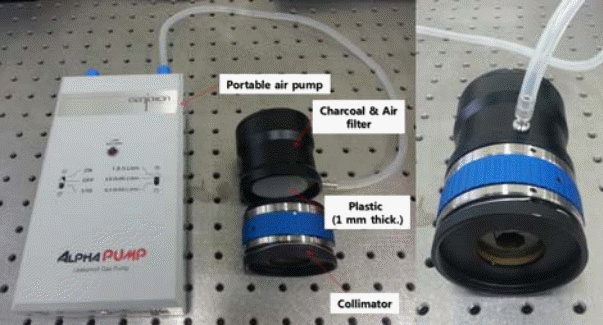Development and Performance of a Hand-Held CZT Detector for In-Situ Measurements at the Emergency Response
Article information
Abstract
Background:
A hand-held detector for an emergency response was developed for nuclide identification and to estimate the information of the ambient dose rate in the scene of an accident as well as the radioactivity of the contaminants.
Materials and Methods:
To achieve this, the most suitable sensor was first selected as a cadmium zinc telluride (CZT) semiconductor and the signal processing unit from a sensor and the signal discrimination and storage unit were successfully manufactured on a printed circuit board.
Results and Discussion:
The performance of the developed signal processing unit was then evaluated to have an energy resolution of about 14 keV at 662 keV. The system control unit was also designed to operate the CZT detector, monitor the detector, battery, and interface status, and check and transmit the measured results of the ambient dose rate and radioactivity. In addition, a collimator, which can control the inner radius, and the airborne dust sampler, which consists of an air filter and charcoal filter, were developed and mounted to the developed CZT detector for the quick and efficient response of a nuclear accident.
Conclusion:
The hand-held CZT detector was developed to make the in-situ gamma-ray spectrometry and its performance was checked to have a good energy resolution. In addition, the collimator and the airborne dust sampler were developed and mounted to the developed CZT detector for a quick and efficient response to a nuclear accident.
1. INTRODUCTION
The emergency responses during a nuclear accident demands information regarding the ambient dose rate and deposited radionuclides on the ground. In particular, rapid determinations with the in-situ measurement are indispensable in the early phase to estimate the amount released and design a response strategy. Since a portable high purity Ge (HPGe) detector is usually used to survey deposited gamma nuclides, the aspect of its cooling and collimation can hinder a rapid response. The advent of a hand-held detector in which the energy resolution is sufficient to identify the detected gamma nuclides and cooling is not necessary provide great efficiency for an in-situ measurement during an emergency response. A cadmium zinc telluride (CZT) detector, which is a compound semiconductor consisting of cadmium, zinc and telluride, has a good resolution, requires no cooling, and has a high dose rate capability [1-3]. Therefore, a CZT detector can be selected to be the most suitable detector for the spectroscopic identification of gamma nuclides during an emergency response even with a very high count rate at room temperature.
In this study, a hand-held CZT detector was developed using a CZT sensor with a volume of 0.5 cm3 (CZT500S, GBS Elektronik GmbH, Groberkmannsdorf, Germany), and making up the signal processing circuits with an on-board type. First, a detector body with a hand-held type was designed to be divided into two parts, the signal process and the system control. A preamplifier for the pulse shaping from a CZT sensor was modified so as to be connected to the printed circuit board (PCB) with several circuits for the signal processing, such as an amplifier, pile-up rejection, pole-zero cancellation, base line restoration, and multichannel analyzer. These components were inserted into a cylindrical detector body, and the performance was then evaluated to have a good energy resolution of about 14 keV at 662 keV. In the system control part, the GPS (global positioning system), internal battery and DC (direct current) input, LCD (liquid crystal display), control buttons, and several interfaces, such as Bluetooth, USB, and RS232, were arranged with the on-board type. In addition, a collimator [4], which can control the inner radius, and the airborne dust sampler, which consists of an air filter and charcoal filter, were developed and mounted to the developed CZT detector for the quick and efficient response of a nuclear accident (Korean patent 10-1482016; Collimator for radiation detector).
2. MATERIALS AND METHODS
2.1 CZT semiconductor
An in-situ gamma-ray spectrometer for an emergency response should place an emphasis on the portability with a small size for quick and efficient operation, although it would be an antithetic concept with respect to the radiation detection with a good resolution and efficiency. In general, a CZT is known to have a good resolution with about a 4.64 eV W-value, wide band gap of about 1.57 eV without cooling required, and a small volume. Therefore, the unique combination of spectroscopy and very high count rate capability at room temperature can make a CZT semiconductor as an ideal detector for the emergency response.
2.2 CZT sensor and preamplifier
A CZT with a volume of 1x1x0.5 cm3 was selected to be an optimized sensor to achieve the information on the dose rate and the radioactivity due to the contaminants, such as 131I, 134Cs, and 137Cs in a nuclear accident response. The CZT sensor and preamplifier with specifications of an energy resolution of below 18 keV at 662 keV and a signal rise time of below 200 ns at 50 pF, respectively, were used to make the hand-held detector.
2.3 Modification of a preamplifier
To compose the signal processing circuits with an on-board type, the output of a preamplifier was modified to connect the PCB, as shown in Fig. 1. The cable connections from its output should be designed to supply high voltage for the CZT sensor operation and low voltage to the preamplifier operation and to output the sensor signal. After modifying the output of the preamplifier, its performance was checked from the measurement of the rise time using a point source of 137Cs. There was no degradation in the performance for the combination of the CZT sensor and modified preamplifier.
3. RESULTS AND DISCUSSION
3.1 Signal processing unit
In general, a signal processing unit in a radiation detector means an amplifier and plays the role of pulse shaping and amplifying. It consists of several circuits for the pile-up rejection, pole-zero cancellation, baseline restoration, and amplification, and directly affects the performance parameters as a radiation detector, such as the resolution and efficiency [5]. As shown in Fig. 2, the signal processing board was manufactured by arranging the amplifier circuits, the power circuit, and interfaces for the analog and gate signal.
Since the output of a preamplifier has a long decay time of about 10 to 200 μs for the sufficient collection of charges produced in a sensor, the pile-up of pulses can be shown by increasing the input count rate in a sensor. In addition, the pulse can undershoot the baseline after the pulse shaping and the baseline can also be fluctuated. They directly impact the resolution of pulses in the measured energy spectrum. Fig. 3 shows the results of the developed signal processing unit from a point source of 60Co just in front of a CZT sensor through the solutions using the pole-zero cancellation, pile-up rejection, and baseline restoration circuit.
3.2 Signal discrimination and storage
After the signal processing unit, the output from an amplifier is sent to the multichannel analyzer (MCA), which consists of an analog-to-digital convertor (ADC), CPU, and memory, to discriminate the pulse height and store it according to the its value representing the pulse height. Fig. 4 shows the developed the signal discrimination and storage unit, which is located under the signal processing unit. In its PCB part, the TxD (transmit data) and RxD (receive data) circuit was added to transmit and receive the data and the interface was then built on the board to communicate the digital signal and supply the power to the power circuit in the signal processing unit. A modified preamplifier is inserted into the space between two boards for the compact design of the hand-held CZT detector.
These components including the signal processing unit were inserted into a cylindrical detector body, as shown in Fig. 5, and the performance was then evaluated from the measurement of the energy resolution. Fig. 6 shows the energy spectrum for a point source of 137Cs from the developed CZT detector. The full energy absorption peak of gamma-rays from 137Cs was measured with a good energy resolution of about 14 keV at 662 keV and two K x-ray peaks of about 32 and 36 keV from 137Ba were also measured in the energy spectrum of 137Cs. The results of the measurement of the energy resolution using several point sources are shown in Fig. 7. Since the energy resolution was well defined until the photon energy of about 1.0 MeV, the developed CZT detector was sufficient to apply to the in-situ measurement of 131I, 134Cs, and 137Cs in the nuclear accident response.
4. SYSTEM CONTROL UNIT
The system control unit was designed to operate the CZT detector, monitor the detector, battery, and interface status, and check the measured results of the dose rate and radioactivity. In the system control part, as shown in Fig. 8, the GPS, internal battery and DC input, LCD, control buttons, and several interfaces, such as Bluetooth, USB (universal serial bus), and RS232 (recommended standard-232), were arranged with the on-board type. In the interface, Bluetooth and RS232 are dedicated to identify and remotely control the measured energy spectrum and the dose rate, and the USB is used to upgrade the system and analysis algorithm in the CZT detector. Several buttons and LED (light emitting diode) lamps were mounted to monitor the status of the battery, the detector operation, and the Bluetooth interface. In addition, by mounting a tripod to the detector body, the remote control for all processes was achieved using the Bluetooth interface between the detector and a laptop. Fig. 9 shows the final version of the developed in-situ gamma-ray spectrometer based on the CZT detector.
5. COLLIMATOR AND AIRBORNE DUST SAMPLER
For a rapid response to a nuclear accident through in-situ gamma-ray spectrometry, several collimators with different inner radii should be prepared according to the level of the ambient dose rate. This makes a quick response impractical and thus a collimator was then developed to have a function of controlling the inner radius with the same method used in a commercial camera lens. The attenuation ratio according to the inner radius, which was calculated from the Monte Carlo simulation, was marked on the outer scale ring of the collimator. An airborne dust sampler, which consists of an air filter and charcoal filter, was modified to attach to the front of a collimator, as shown in Fig. 10. This sampler is for the sampling airborne dust in the field survey for the emergency response with it mounted on the CZT detector. Therefore, the continuous analysis of the airborne dust will be conducted through the in-situ gamma-ray spectrometry using the CZT detector.
6. CONCLUSION
To determine the source and its amount of contaminants and divide the contaminated areas in the response of the nuclear accident, the information on the ambient dose rate in the scene of the accident and the radioactivity of the contaminants should be quickly, efficiently, and accurately corrected by mobilizing possible methods. In this study, for the above purpose, the hand-held CZT detector was developed to make the in-situ gamma-ray spectrometry and its performance was checked to have a good energy resolution. In addition, the collimator and the airborne dust sampler were developed and mounted to the developed CZT detector for a quick and efficient response to a nuclear accident.
Acknowledgements
This work was performed under the auspices of the Ministry of Science, ICT and Future Planning (MSIP) of Korea, NRF contract No. 2012M2A8A4025915.









